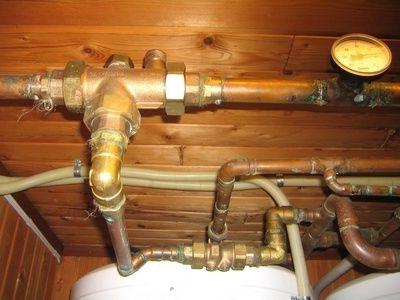In the heating system of any home is a certain amount of coolant. From the course of physics, from school, everyone knows that when heated, fluids increase in volume, expanding at the same time. This additional volume must be located somewhere, otherwise the system will resemble a makeshift bomb. In order to avoid the danger of an explosion, a special expansion tank is used, into which the formed excess liquid enters.
The size of a suitable expansion tank should be selected individually in each case. It will depend on the total amount of coolant in a particular system.
In modern double-circuit boilers, such a capacity is built into the body. The owners do not immediately notice it, because it is hidden under a metal case. The volume of the expansion tank in such boilers reaches an average of 12 liters. Manufacturers themselves know the approximate size of the room for which the device is designed, so they install their expansion tank. It has a certain reserve of space for an increasing volume of liquid. The expansion tank for heating, which is built into the wall-mounted boiler, can be increased or replaced with a larger, roomier model.
Types of appliances
1. Previously, the most common model was an expansion tank of an open heating system. Its principle of operation is similar to the action of a pan with a lid or a container with a welded pipe. Excess water flows through it in case of heating, and then, when the coolant cools down, for example, when the boiler is off, it goes back to the system. Often, overflow tanks are built in open tanks - another pipe at the top. Over it, the excess coolant is removed (usually into the sewer). Often owners do without an expansion tank at all, installing a “overflow” at the highest point of the system. At the same time, care must be taken to ensure that a sufficient supply of water remains in the pipes. The disadvantage of this model is the corrosion of the tank and the large evaporation of the coolant in contact with air. The advantage of this type of tanks is the simplicity of design and low cost of installation.

2. Modern models are equipped with closed tanks. Such an expansion tank for heating consists of two cavities. One of them is designed to circulate the coolant, the second contains air or nitrogen. Cavities are separated by a special membrane, which stretches with a decrease or increase in the volume of coolant. In this case, the pressure in the entire system remains virtually unchanged. Such an expansion tank has certain advantages - the coolant does not evaporate, it is not necessary to put such a tank at the highest point of the system. The disadvantages of this design are the high price and large volume, because half a tank occupies a gas tank.
To calculate the required optimal volume of the expansion tank, multiply the volume of the coolant by 0.08. So, for a system for 100 l of coolant you will need an expansion tank for heating at least 8 l.